The 2016 Razer Blade Pro Review
by Brandon Chester on March 6, 2017 8:00 AM EST- Posted in
- Laptops
- Razer
- Razer Blade Pro
sRGB Accuracy
The Razer Blade Pro uses a 17.3" 3840x2160 display. Like almost all of Razer's laptops, this is not an IPS panel. I suspect that it's some sort of vertical alignment tech, but I've been unable to track down the specifics of the panel even though it's known to be a display from Sharp. However, the viewing angles on the Blade Pro are very good, and it doesn't suffer from the yellow tint when viewed off-axis that I noticed on Josh's 14-inch 2014 Blade.
Razer also advertises that the display covers 100% of the Adobe RGB color gamut. I've talked about the issues of using wide-gamut displays on non-color managed platforms so many times in the past that I've grown tired of it, and I'll save it for later when it's most directly relevant. The use of Adobe RGB does necessitate a change from the standard laptop display workflow, so I've split the testing into two sections. This section goes through the standard sRGB analysis to see how things are reproduced in the standard gamut used by almost all computer content, and the next page covers accuracy relative to Adobe RGB and then goes through a greyscale calibration with that gamut as the target.
As always, measurements are done with an X-Rite i1Pro 2 spectrophotometer, except for black level measurements which are done with an X-Rite i1Display Pro colorimeter. Data is profiled and analyzed using SpectraCal's CalMAN software.
Brightness and Contrast
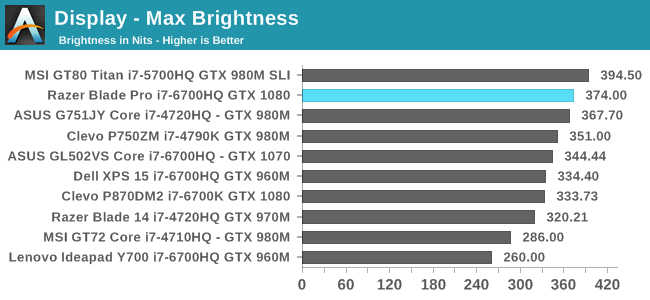
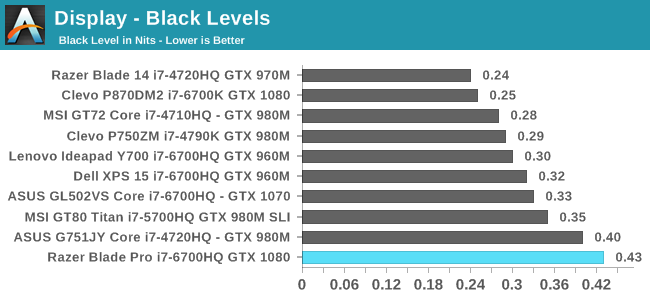
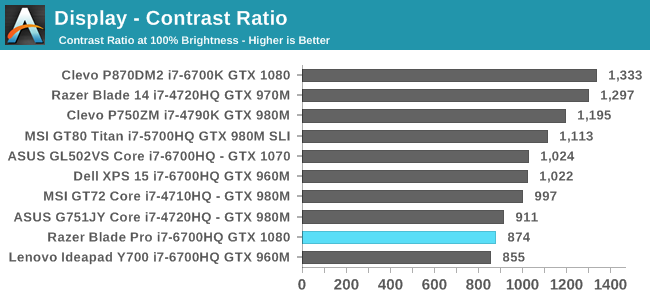
The peak brightness on the Blade Pro is quite good among gaming laptops, but the black level is surprisingly high. The panel razer is using isn't performing as well in this regard as the one used in the smaller 14-inch Razer Blade. I suspect that Razer has little control over this as they need to pick a suitable panel from those that already exist on the market, but it's still disappointing nonetheless.
Greyscale
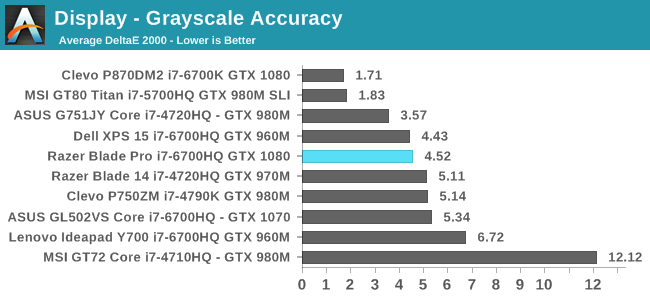
Greyscale accuracy on the Blade Pro is rather poor for such an expensive machine. It's important to note that although this is measuring against sRGB, the white point of D65 and gamma of ~2.2 for our testing doesn't change when testing against Adobe RGB, so this result is applicable to both.
It's clear from the results above that the gamma is too high, with an average value of roughly 2.4 over the entire curve, and a large section where the value is between 2.5 and 2.6. This leads to a generally darker image, as it takes longer for the greyscale to come out of the shadows. However, it would be one thing to have a consistently high gamma, but in this case the issue is both values that are higher than expected and general irregularity in the gamma curve itself.
In addition to the errors caused by the incorrect gamma value at each point, the balance of red, green, and blue components tends towards red for most shades. This causes a noticeable red shift to the display, and the low green component of luminance means that Razer's default calibration actually reduces the display's peak brightness.
The red shifting combined with the irregular gamma leads to a relatively high error level for most shades of grey, with only the very darkest shades providing an acceptable level of accuracy. I honestly don't know what sort of settings Razer was targeting here, because as I mentioned before, these values aren't in line with the spec for sRGB or Adobe RGB, so it's not as though the performance here is going to improve when measuring against Adobe RGB.
Saturation Sweep
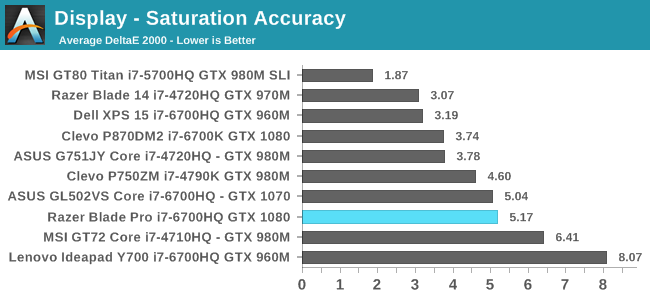
Given that the Blade Pro targets Adobe RGB, it's not surprising to see high error levels for all colors. Even in the case of blue, which has a similar representation for Adobe RGB and sRGB, the red shifting and errors in the gamma throw off the accuracy for all but the deepest levels of saturation. Red is quite inaccurate as well, and green is just hilariously inaccurate, although to be fair, that result is not unintended on Razer's part.
Some readers may be wondering why the errors for red saturation levels are so high even though Adobe RGB and sRGB share the same chromaticity coordinates for red. This highlights one of the limitations of comparing color gamuts using chromaticity diagrams. Although the coordinates for red are the same on the CIE 1976 UCS diagram, the actual CIE XYZ tristimulus values for the colors are not the same. A more simple explanation is that because the green primary in Adobe RGB is significantly more saturated than sRGB, the intensities of red and blue have to be increased in order to maintain the same white representation.
This is fairly intuitive when you think of extending the colors in sRGB. If you represent white in sRGB as (1,1,1), and you increased the saturation of green without corresponding changes to red and blue, your white would start to tend more toward green. Consequently, the appearance of red and blue in Adobe RGB is actually not the same as in sRGB despite the chromaticity coordinates being the same, although in the case of blue the error introduced is on a much smaller scale than for red.
Gretag-Macbeth ColorChecker
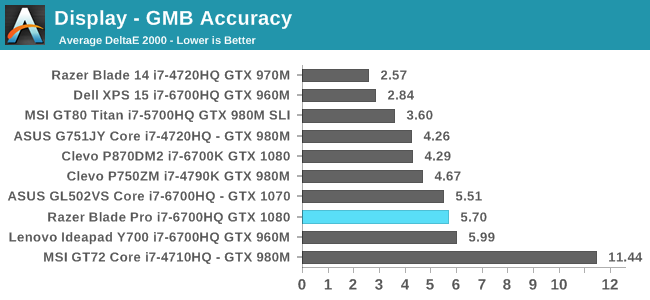
With less than stellar saturation and greyscale accuracy, it's not surprising to see that the Blade Pro struggles to reproduce color mixtures when targeting sRGB.
I really don't have much to say about the Blade Pro's accuracy relative to sRGB, because it was clear to me that it would be poor before I even tested it. If you target one color gamut, you won't be able to correctly reproduce content designed for another color gamut unless you have color management. Windows essentially has no functioning color management, and the few apps that are color managed end up rolling their own solutions or integrating good open source solutions like LittleCMS. Razer should be providing an sRGB color mode much like Microsoft has done on their Surface Studio, which allows proper sRGB color reproduction even with a display that natively has a wider color gamut. If you need sRGB accuracy, the Blade Pro isn't for you.


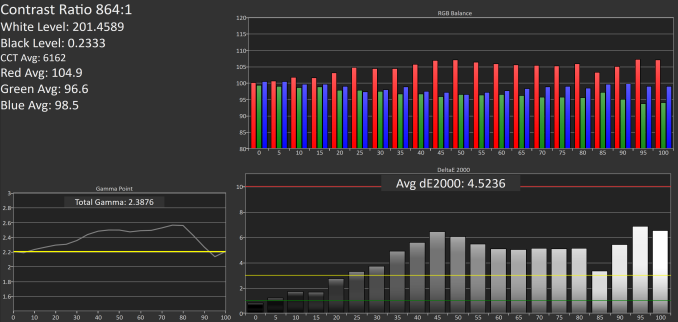
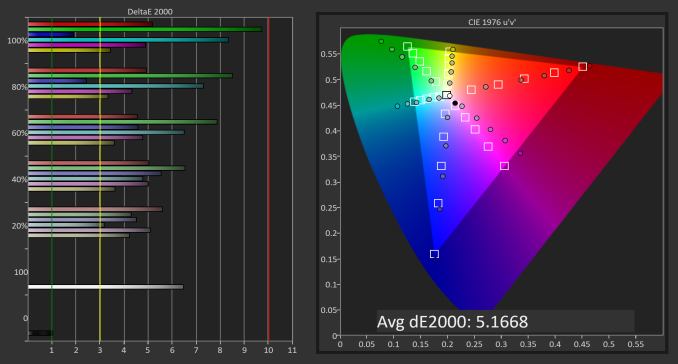








57 Comments
View All Comments
fanofanand - Monday, March 6, 2017 - link
I bought my wife a cheap $350 Acer (because she doesn't know the difference) and despite her repeated attempts, she has been unable to destroy it. Plastic is not premium, but is great when you are building things to a price point. Most consumer electronics sold are not the top-end gear.BrokenCrayons - Monday, March 6, 2017 - link
I think the part I don't like about plastic laptops are those metal-in-plastic screw fittings where there's a little threaded cylinder for the screw that has that knotty outside and get stuffed into a hollow plastic tube. (No idea what the technical name for those things are.) The plastic sometimes will crack around them and the screws along with the threaded cylinder thingies will break free.Barilla - Monday, March 6, 2017 - link
Ok, just to clarify - I have no issue with this laptop being made of aluminium, I even agree it's a good choice, although if I wanted to be picky, there are carbon fibre materials with thermal conductivity equal to or higher than aluminium.I meant it on a more general level as your comment about carbon fibre mentioned Dell XPS, which in it's 13" version houses a 15W CPU and no dGPU, which means it needs to dissipate at most 1/10th the heat this laptop does.
Really, nothing against aluminium. Or magnesium either, as I'm typing this comment from a Surface. All I'm saying is that plastic, and especially carbon fibre, is a perfectly fine material in many - not all - applications, including some laptop and smartphone chassis.
Peace.
Azurael - Monday, March 6, 2017 - link
I wonder whether people will ever get beyond that 'it looks more premium' mindset with CFRP (or even polycarb) vs. metals. Personally, I'd prefer to be able to buy 'plastic' versions of any portable electronics for impact resistance, metal devices are far too easy to dent and break. It's all very well having a metal phone or laptop, but if you have to keep it in a plastic/rubber case all the time to keep it safe, I don't see the point.simonm - Monday, March 6, 2017 - link
Carbon fibre is strong but to the best of my knowledge not usually a good conductor of heat except for certain specialised versions.So unless Razer went with some kind of super carbon fibre the case won't be able to facilitate cooling (like an extended heat sink) as well as if it were aluminium. I doubt Razer did use a high conductivity fibre or they'd be marketing the hell out of that.
Instead they chose it probably for its high strength/rigidity to weight ratio, lower cost than aluminium and marketing because it sounds cool and high end.
If money (and weight) wasn't an option you could use lots of metal alloys that are more conductive than aluminium. Copper... gold ;)
simonm - Monday, March 6, 2017 - link
Correction: change option to issue!PS: So I think most people are looking down on the CF for its thermal properties when compared with aluminium. Aluminium offers good weight and thermal properties but with high expense and lower hardness/rigidity than carbon fibre.
With a 1080 packed in there and a 180 W power adapter I reckon you'd want as much help dissipating heat as you can get. So carbon fibre seems like something of a compromise.
colonelclaw - Monday, March 6, 2017 - link
Surely carbon fibre is much more expensive than aluminium? That's the impression I always got from products that use it, or is that just marketing?fanofanand - Monday, March 6, 2017 - link
Carbon Fiber (the high-tech variety) is far more expensive than aluminum.Bullwinkle J Moose - Monday, March 6, 2017 - link
if money (and weight) wasn't an option.....Diamond plated Silver would be a far better thermal conductor than Copper or Gold
Diamond has 3X the thermal conductivity of even silver
But a diamond frost coat on copper would look better
A Rose Gold that costs as much as real Gold
Sound like an Apple Product!
SkipPerk - Wednesday, April 19, 2017 - link
In order to plate the silver to make it strong enough I think it would interfere with the thermal transfer. I think nickel-plated copper would be the better choice, although it would still be soft. Aluminum really is the best choice.